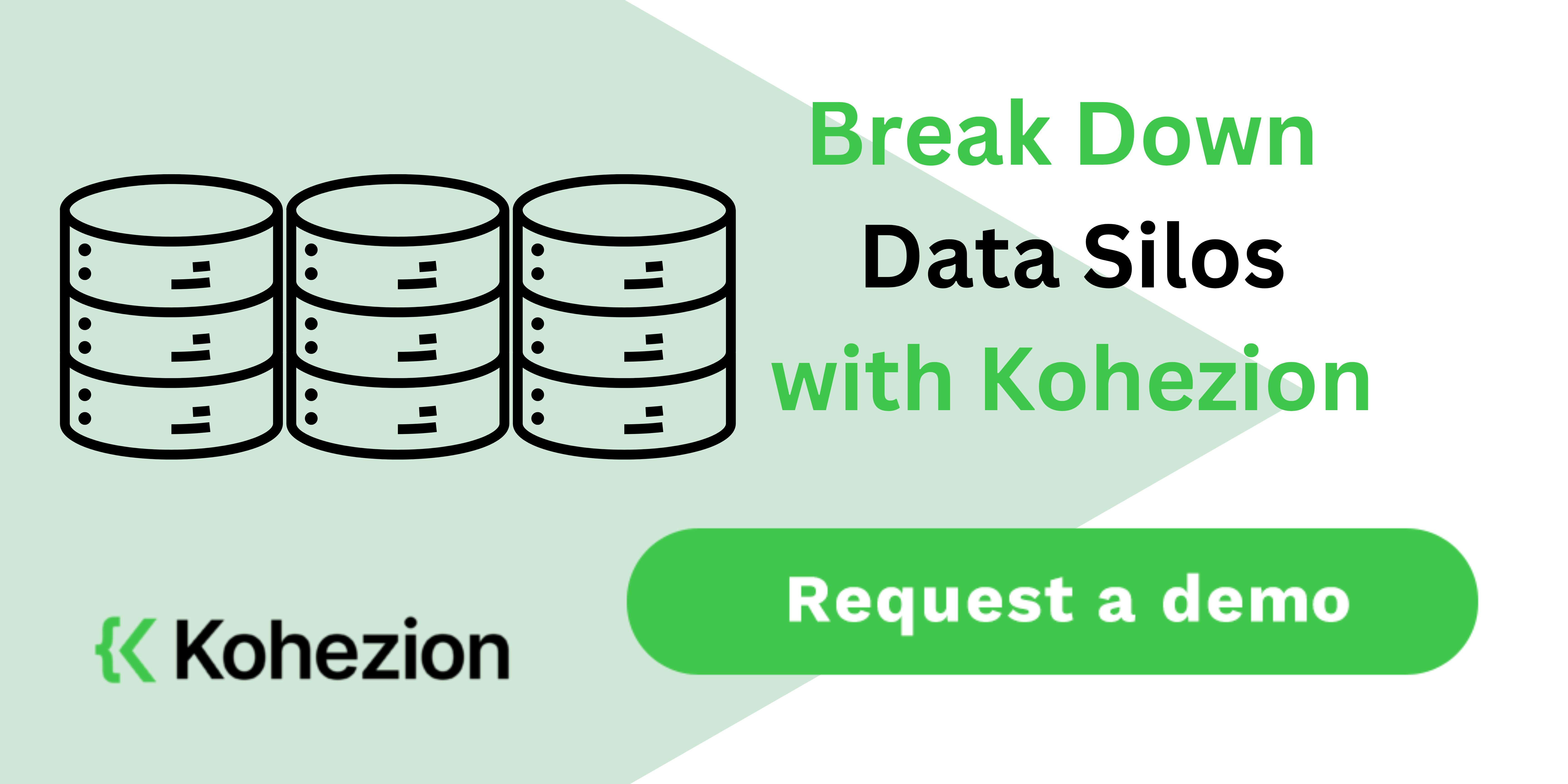What are data silos?
Data silos are isolated repositories of data controlled by one department or business unit that are typically incompatible with other data sets. These silos can develop due to technical issues, separate goals, and priorities among teams or departments, or even individual preferences. For example, one department may use a software application that is not accessible to another department, resulting in isolated information that corrupts the organization’s data quality.
Data silos can negatively impact businesses by causing a lack of transparency, efficiency, and trust within the organization. This can lead to inconsistencies in overlapping data, making it difficult to access company data that spans departments and systems and resulting in disconnects between departments. Ultimately, this can impede effective decision-making, which can hinder business growth.
What causes data silos?
1. Different Systems and Software
Different departments in organizations tend to rely on different technology solutions and tools to support their operations, such as spreadsheets, accounting software, or CRM. These legacy systems were not designed to easily share information, and each solution stores and manages data in different ways, often proprietary to the vendor that created the solution, making it hard to share data sets with stakeholders in another department.
Moreover, many SaaS applications that organizations rely on to manage core processes don’t directly integrate with one another, making it impossible to share information across the organization. When organizations lack access to technology that prioritizes communication between different data sources, it inevitably leads to
data silo issues, as data cannot easily pass between departments. Decentralized IT services, allowing departments to buy their own software and technologies, also lead to databases, platforms, and other applications that are not compatible or connected to other systems within the organization.
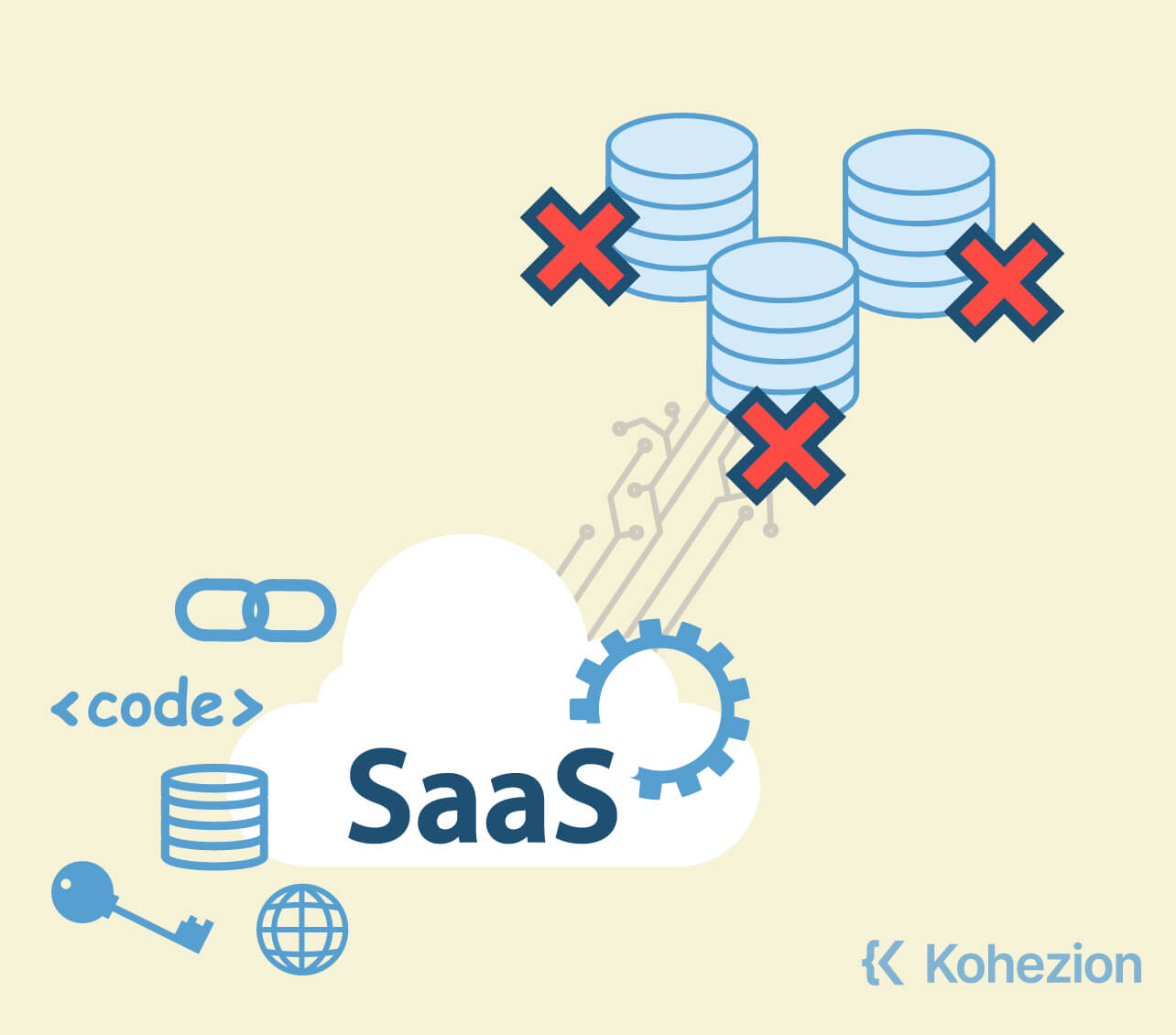
2. Lack of Data Integration Capability
The lack of data integration capability can cause data silos by preventing different systems from communicating with each other, resulting in disconnected data sources. This can lead to poor data management, inaccurate insights, and slow decision-making. For instance, without integration between sales and marketing systems, it can be challenging to attribute leads to revenue and identify the best-performing channels.
3. Varied Team Collaboration
Limited visibility across different teams can result in parallel work and wasted resources. When teams only have access to their specific data, it can lead to a “stay out of my sandbox” mentality and a hyperfocus on individual objectives. This creates a divided organization and makes it nearly impossible to achieve enterprise-level goals or a shared vision.
Varied team collaboration can cause data silos as teams working on an independent initiative may miss vital data streams or accidentally integrate similar data sets that should be separate. To prevent or minimize the problem, leaders should communicate the problems with information silos versus the benefits of data sharing and provide regular training to promote employee buy-in.
4. Lack of a Centralized Data Source
Having a centralized data source is crucial for preventing data silos and ensuring that all relevant business data is connected and accessible to decision-makers. By integrating multiple business tools and databases into a central database, organizations can streamline data across teams, reduce time-to-insights, and improve business agility.
Data centralization also helps to prevent data leaks and data breaches by providing greater control over how data is gathered, stored, and analyzed. Companies such as Coca-Cola and Airbnb have successfully implemented centralized data sources to overcome data silos and improve their decision-making processes. By breaking down communication barriers between departments and ensuring enterprise-wide standards for data collection and storage, these companies have been able to achieve greater efficiency and productivity.

5. Technology Silos
Technology silos are a major contributor to data silos, which can create significant problems for businesses. When different departments within an organization use different software to store their data, it can be difficult to access that data through a common interface. This is known as a technical data silo.
Additionally, new applications that don’t integrate with a company’s existing technology or analytics stack can generate silos. To overcome these issues, businesses need to own high-quality applications that can handle quick transfers of information and cross-references. One option is to unify data on a modern platform geared for sharing and collaboration via an easy-access web interface. While this may be a long-term project, it could pay dividends as the business grows.
6. Data Quality and Integrity Issues
Data quality and integrity issues play a major role in causing data silos. When data is inaccurate, incomplete, or outdated, it becomes difficult to integrate with other sources of data. This leads to data silos where different departments or teams have their own isolated sets of data that do not connect with other sources. Inaccurate or incomplete data can also introduce inconsistencies in the information flow of a company, making it difficult to make informed decisions.
To break down data silos, it is important to encourage data ownership and transparency and to ensure that everyone in the company understands the importance of creating and storing good-quality data. It is also important to have standardized and cohesive data bridges with infallible structural integrity to ensure that data can be integrated effectively.
7. Difficulty in Accessing Data
Difficulty in accessing data can contribute to data silos when relevant business data cannot be connected to a central database. This often leads to multiple sets of data being stored in different sources that don’t connect on the back end, making data sharing difficult. Organizations often rely on multiple business tools and databases that may not fully integrate, resulting in poor data management.
This lack of technological interconnectivity can lead to poor data quality, and when data is stored in someone’s digital folder, it becomes difficult for organizations to put security measures into these archives. As a result, companies may experience data breaches and have difficulty cross-referencing data from different sources, leading to conflicting data and poor-quality insights. This can impact decision-making and slow down business agility, as analysts spend more time finding data from different places.
8. Unclear Data Policies
Unclear data policies contribute to the problem of data silos by allowing individual business units to design their own data management methods, resulting in fragmented data. This lack of guiding principles also allows individual users to create micro-data silos within various applications and devices.
Without proper documentation and governance, there is no shared understanding of collecting, managing, and storing data, leading to employees without guidance on sharing the data they collect. This can result in data leaks and compromised data, making it difficult to uphold data integrity.
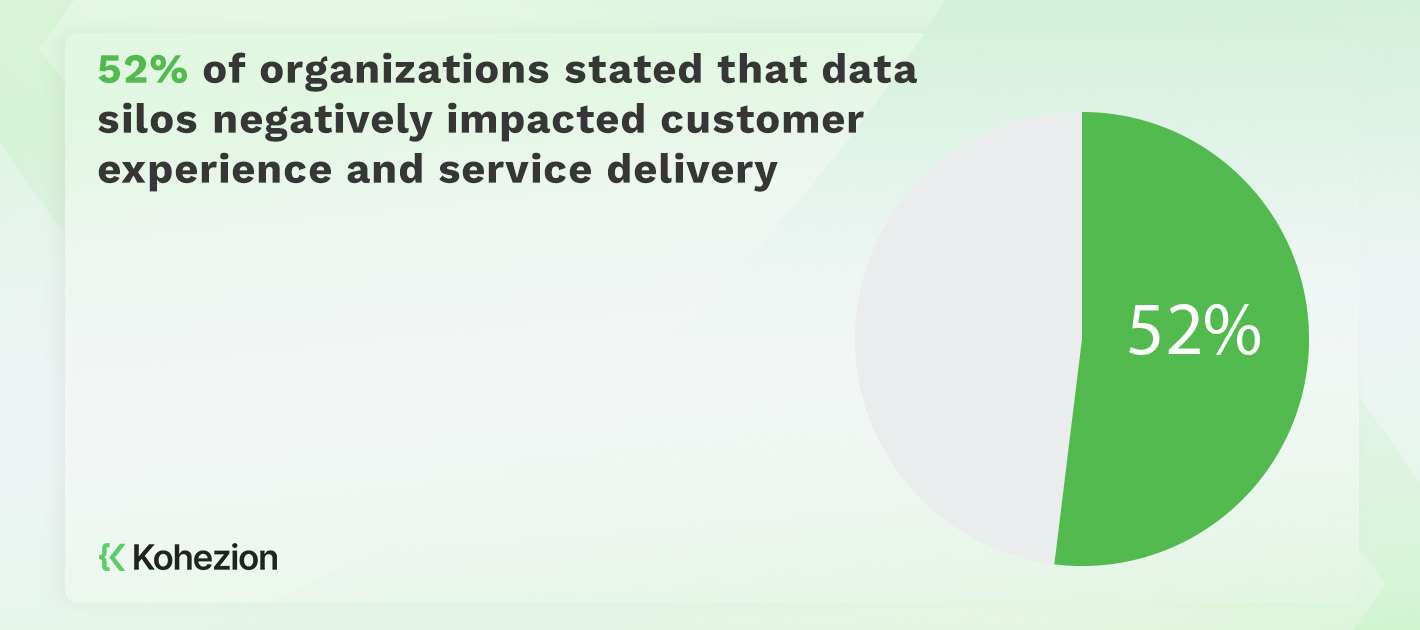
What are the reasons why data silos are problematic?
1. Unreliable Data
Unreliable data in data silos can create a host of problems for organizations. Data that is not freely shared can lead to conflicts between employees and departments. Multiple sets of data (often duplicates) can burden the company’s financial resources allotted to storage space.
When relevant business data can’t be connected to a central database, the insights that decision-makers arrive at will not reflect the true state of business operations.
2. Poor Data Quality
Poor data quality contributes to the problem of data silos in several ways. Firstly, when data is outdated, incomplete, or missing, the value that businesses can get from it decreases significantly.
Secondly, when multiple sets of the same data are stored by different departments, the resource quality suffers, and the data becomes skewed in favor of the team that owns it.
Lastly, data silos result in poor-quality data because these fragmented pieces of information are difficult to assemble, leading to conflicting data when cross-checking information from different sources.
3. Poor Efficiency
Data silos refer to the isolation of data within an organization’s various departments, which can lead to poor efficiency in business operations. This results in multiple sets of data, often duplicate, which burdens the financial resources of the company allotted to storage space.
Moreover, when various departments download this information, the resource quality suffers, resulting in decreased productivity that can negatively impact the bottom line. In addition, data silos can cause your team to lack agility and adaptability by making it harder to quickly address customer issues, causing data fatigue, and creating challenges for informed decision-making.
4. Lack of Transparency
Lack of transparency is a major contributor to the problem of data silos in an organization. When data is not freely shared, it creates conflict between employees and departments, hindering collaboration and cooperation. Teams end up working independently, with access only to their own data, which creates a divided organization. This makes it difficult for the company to share a common vision and for leaders to make decisions based on data.
Data silos can arise naturally due to a lack of communication between departments, resulting in reduced opportunities for data sharing and collaboration.

5. Ineffective Decision-Making
Data silos in businesses can lead to ineffective decision-making by preventing decision-makers from accessing all the necessary information. When each team or department has access only to its own fragment of data, they are unable to see the big picture and make decisions aligned with global business goals.
This can create a divided organization where teams do not collaborate with each other, leading to a lack of agility and adaptability. Incomplete business data resulting from data silos can jeopardize data integrity, leading to poor business decisions or even disasters. Moreover, data fatigue, challenges for informed decision-making, and reduced time-to-insights are other consequences of data silos that can contribute to flawed decision-making.
6. Increased Costs
Data silos can lead to increased costs for businesses in several ways. Firstly, storing duplicate or outdated data in multiple silos burdens financial resources and leads to unnecessary storage costs. Secondly, dealing with data silos can result in missed sales opportunities and decreased productivity, which can negatively impact the bottom line. Thirdly, if decisions are made based on inaccurate data due to siloed information, it can lead to poor business outcomes and hurt revenue.
For instance, inaccurate data during a product launch can result in sending the wrong email to customers, destroying customer trust and affecting ROI. Additionally, integrating the sets of data in a cohesive manner requires a large amount of human capital, which can further increase costs.
7. Lack of Customer Experience Agility
Data silos can negatively impact customer experience agility by making it difficult for organizations to provide accurate customer service. When customer data is stored in different silos, agents may not have access to the information they need to quickly resolve customer issues. This can lead to negative experiences such as long wait times, endless transfers, and customers having to repeat themselves.
Additionally, data silos can cause decreased productivity and missed sales opportunities, as agents may be too busy gathering data to effectively upsell or nurture existing prospects. Data silos can also hinder team cooperation and coordination, leading to inefficient decision-making and a lack of agility in responding to
customer needs.
8. Reduced Productivity
Data silos, or the isolation of data within individual departments and teams, can lead to reduced productivity in an organization. This is because users who need data outside their range must first identify the teams that own the data and then request permission to access the data before they can finally analyze it for their purpose. This process can be time-consuming and can result in missed sales and upselling
opportunities.
For instance, if agents are too busy working overtime to gather data, a lead may slip through the cracks, making it harder to nurture existing prospects. Moreover, data silos can cause duplicative efforts, as different teams end up doing the same work in parallel due to limited visibility across the organization.
9. Increased Risk of Security Breaches
Data silos refer to the practice of storing data in separate, decentralized locations, which can pose a significant risk to an organization’s security. When data is stored in silos, it becomes more challenging to implement centralized security measures, increasing the threat of data breaches. This is because there is no overarching control over how data is collected, analyzed, or accessed, making it more challenging to track down who has access to what.
Moreover, data silos make it difficult to comply with data privacy laws, which can result in severe legal and financial consequences. For instance, if employees store data on non-approved applications or their individual devices, it can increase the security risk for the company if proper security controls are not in place.
Additionally, silos hinder the ability to establish a comprehensive and effective data governance framework, putting businesses at risk of cyber threats and data breaches.
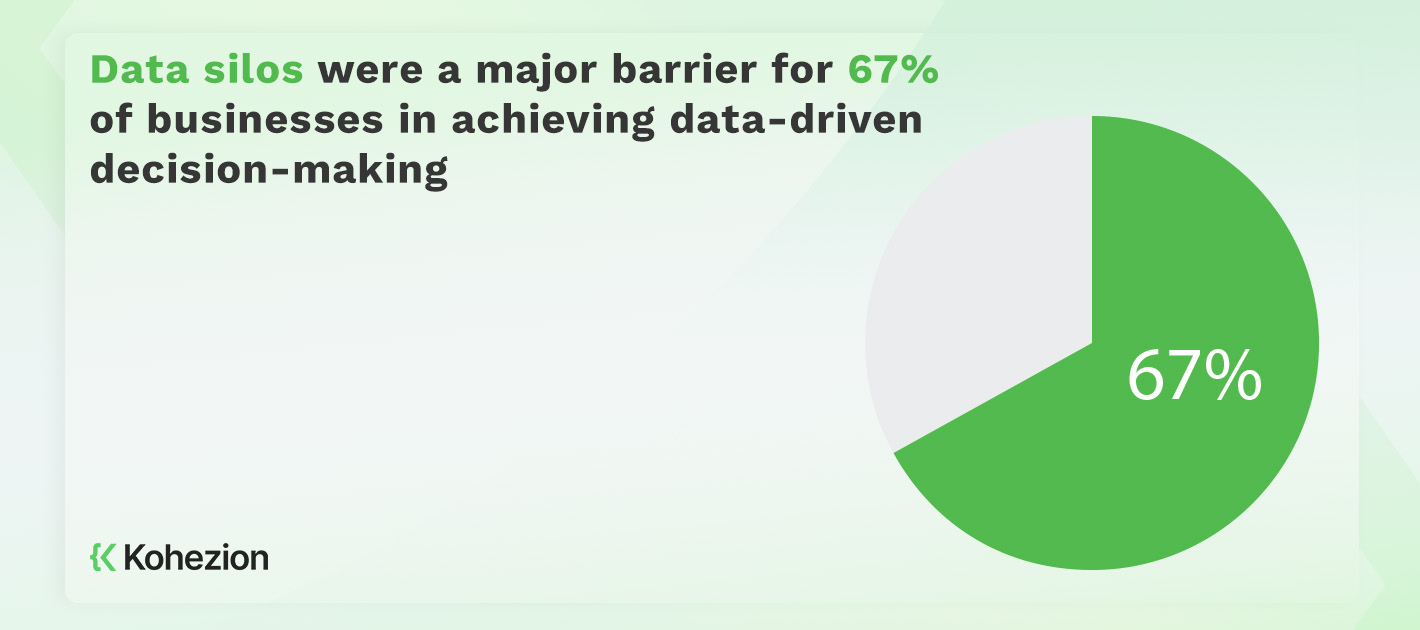
What are the signs that you have a problem with data silos in your business?
1. Conflicting and inconsistent data
Conflicting and inconsistent data is a common sign of a problem with data silos in a business. When data is stored in different databases, inconsistencies can arise between departmental data. For instance, a customer’s address may be stored in different formats, leading to data inconsistencies. In addition, when data is not freely shared, conflicts can arise between employees and departments. This can hinder
collaboration and result in incomplete business data, jeopardizing data integrity.
2. Lack of data sharing
A lack of data sharing can indicate the presence of data silos within a business. Silos occur when data is isolated in different sources that don’t connect on the back end. This can happen due to bureaucracy, restrictive access control systems, and a lack of technological interconnectivity.
3. Poor data quality
Poor data quality can indicate the presence of data silos within a business. When data is stored in isolated systems without integration, it can become outdated, incomplete, and inconsistent between departments. For example, medical data stored in different systems can become out of sync over time, leading to inaccurate information. Ultimately, poor data quality can lead to business decisions based on inaccurate information, which can negatively impact revenue and customer trust.
4. Lack of data governance capabilities
A lack of data governance capabilities can be a sign of a problem with data silos in a business. When data is fragmented across different sources and there is no shared understanding of how to collect, manage, and store data, individual business units may design their own data and metadata management methods. This results in data silos where relevant data is stored in different sources that don’t connect on the back end, making data sharing difficult. Additionally, individual users may create micro-data silos within their personal devices.
5. Inability to adapt to change
Data silos can impede a business’s ability to adapt to change and hinder its agility. These silos can slow down the time it takes to address customer issues, cause data fatigue, and create challenges for informed decision-making. When data silos are present, teams may spend extra time gathering and processing data, which can lead to outdated information.
6. Unreliable analytics
Signs of unreliable analytics due to data silos include conflicts between employees and departments over conflicting data, difficulty finding the necessary data to make informed decisions, and a lack of data transparency hindering collaboration between different departments. Additionally, working with data silos can lead to poor-quality data and an increased risk of data leaks.
For example, if leads cannot be attributed to revenue due to a lack of sales and marketing alignment, it may be difficult to identify the best-performing channels.
How to avoid data silos before they start?
1. Establish a data governance strategy
Establishing a data governance strategy is crucial for organizations to prevent the formation of data silos. A comprehensive strategy should include data ownership, transparency, metadata management, and a codified system for maintaining data organization.
A robust data governance framework can also facilitate self-service analysis and centralized data access and control, preventing the development of new silos. Additionally, productized data governance capabilities can help organizations market responsibly by clearly labeling and preventing improper data usage.
2. Invest in a centralized data warehouse
By consolidating data from disparate sources into a central repository, a data warehouse can homogenize and consolidate data, making it easily accessible to individuals or groups while balancing business needs against privacy and security.
A centralized data warehouse also enables organizations to develop robust data access policies that facilitate self-service analysis, eliminating the need for IT personnel to serve as gatekeepers. With cloud-based solutions, data warehouses can connect disparate business units into a cohesive ecosystem, giving analysts a 360-degree view of the organization.
3. Create a framework for data-sharing
To create a framework for data sharing, the first step is to identify all the data sources within your organization. Once you have identified the sources, you should define data ownership to ensure that everyone knows who is responsible for each piece of data.
Having a data-sharing framework in place offers several benefits, including improved collaboration, increased efficiency, and better decision-making. By breaking down data silos and promoting data democratization, teams can work together more effectively, lean on each other’s strengths, and make better decisions based on data rather than personal biases.
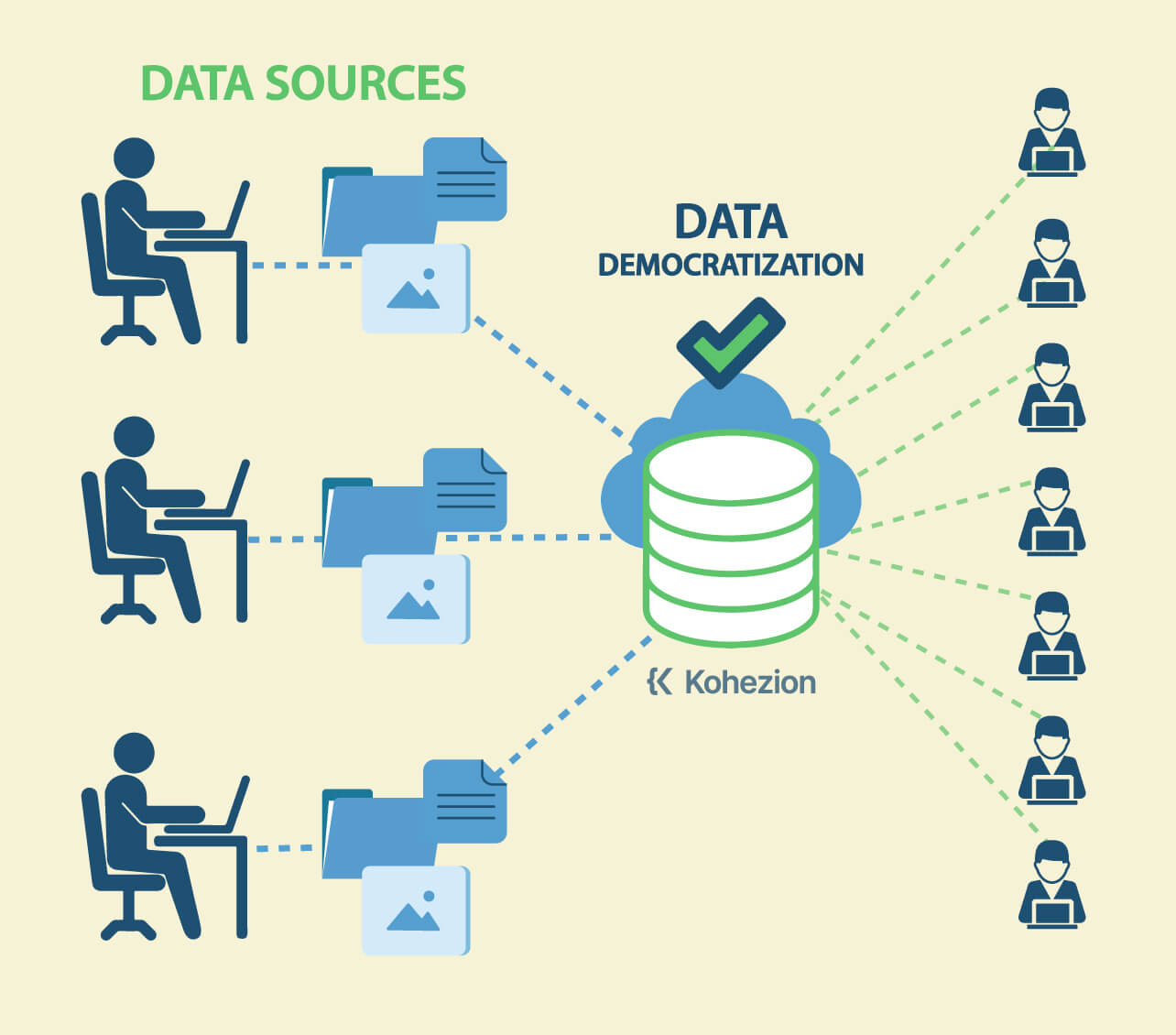
4. Implement business intelligence software
Implementing business intelligence (BI) software can help avoid data silos by allowing for data integration and centralized data storage. By using and creating a business intelligence dashboard, decision-makers can gather and analyze data from multiple sources, discover patterns and trends, and gain insight into improving operations, products, and opportunities. It is important to identify where data silos exist in the organization and develop new processes for storing data.
5. Integrate systems and processes
By having a unified system, data accuracy and consistency can be improved, and information can be shared across departments. This can be achieved through the use of data integration software, such as ETL tools or Integration Platforms as a Service (iPaaS), which automate data transfer and ensure data is converted to a standard format for analysis.
It is important to involve all relevant departments in the integration process to ensure that all data sources are accounted for and included. Failure to integrate systems and processes can result in data assets that are only usable by the teams that produced them, leading to a backlog of cleanup and integration work for IT.
6. Create a data-sharing policy
To create a data-sharing policy that prevents data silos, it is important to have a clear and easy-to-understand policy in place. This policy should encourage data ownership and responsibility for creating and storing good-quality data.
The policy should include guidelines on which teams have access to certain types of data, especially if it contains sensitive, personally identifiable information. To ensure compliance, organizations should look for productized data governance capabilities that allow for responsible marketing. These capabilities should clearly label what data sources are barred from being used in specific cases and include a system that prevents improper data usage.
7. Train your team
To prevent data silos, it is crucial to educate team members on data management and the risks associated with siloed data. Training programs should include best practices for sharing and integrating data, as well as proper use of technology and tools for data transfer. It is important to emphasize the benefits of collaboration and cross-departmental communication in achieving company goals.
Examples of training programs could include workshops on data management and sharing, hands-on training with data management tools, and team-building activities focused on breaking down silos.
How to fix data silos and create a centralized source for business data?
Step 1: Identify the root cause of data silos
Identifying the root cause of data silos is crucial for creating a centralized source for business data. Signs of data silos include inconsistent, missing, incomplete, or insufficient data, and rising IT costs. A structured approach involves contacting IT to get a list of systems used by each department and identifying where data goes missing. Common causes of data silos include departmental autonomy, lack of collaboration, and data sprawl.
Step 2: Choose the right tools to fix data silos
To fix data silos and create a centralized source for business data, it is important to choose the right tools and use them effectively.
- Identify where data silos exist in your business and evaluate your current technology toolkit.
- Decide what type of customer experience you want to provide and empower your support agents to deliver that kind of care.
- Evaluate and select analytics tools that the entire organization can leverage, rather than tools for individual business units.
- Move data from varied systems into a data warehouse, which acts as the repository for all collected data.
- Draw in the data from every department of the organization and invest in analyzing use cases.
- Improves team collaboration and reduces unnecessary interdepartmental competition.
- Use middleware or manually program interactions between two or more applications to enable independently designed applications to work together.
An online database software like Kohezion is the perfect tool for centralizing data.
Step 3: Sort through outdated data
To fix data silos and create a centralized source for business data, start by identifying all the teams who need data and what they need it for. Then, figure out which other departments already record that data and how they’re recording it. Weed out anything unnecessary and eliminate duplicate data.
Next, ensure that all the data in your system is current and accurate. Outdated data is not only useless but can also lead to poor business decisions and hurt revenue. Make sure to regularly review and update your data.
To maintain up-to-date data, consider implementing automated data exports from tools such as CRM and ERP. If this is not possible, third-party solutions are often available that offer a corresponding interface for data integration.
Step 4: Integrate data
Integrating data is crucial to breaking down data silos and creating a centralized source for business data. This process involves identifying where data silos exist in the business, getting different applications to communicate with each other, and building one source of truth for all collected data.
Techniques such as scripting, ETL tools, and iPaaS can help automate data transfer and convert data into a standard format for analysis. Flexible and scalable tools like ETL platforms can help transform data into one format and load it to a data warehouse.
Step 5: Choose applications wisely
Choosing the right applications is crucial to break down data silos and create a centralized source for business data. It is common for organizations to use multiple applications across departments, resulting in multiple sources of information, making it difficult to share. To avoid this, it is important to select applications that can integrate with each other and share data seamlessly. For instance, some applications have native or in-app integrations for popular use cases, such as CRM and marketing tools, accounting and billing software, and e-commerce and billing apps.
When selecting an application, consider its integration capabilities, compatibility with existing applications, and ease of use. All-in-one solutions or platforms from a single provider can also help avoid
data silos.
Step 6: Create a more collaborative company culture
Creating a more collaborative company culture is key to breaking down data silos and promoting a centralized source for business data. To encourage collaboration and data sharing among different departments and teams, companies can implement several strategies. One effective approach is to host cross-departmental training sessions, where teams can share data and perspectives.
Additionally, company leaders can create a culture that values data sharing and integrity and regularly communicates the benefits of breaking down silos. Standardizing processes across departments and democratizing data also helps to encourage collaboration. Finally, senior management should provide the necessary technologies, policies, and procedures to enable collaboration and data sharing among different
teams.
Step 7: Establish governed self-service access rights
Establishing governed self-service access rights is crucial for fixing data silos and creating a centralized source for business data. This allows business users with permission to easily access the data they need, without IT personnel serving as gatekeepers.
To establish governed self-service access rights, organizations should implement a data governance framework with robust data access policies that facilitate self-service analysis. This should include productized data governance capabilities that prevent improper data usage and clearly label what data sources are barred from being used in specific cases.
Step 8: Implement artificial intelligence solutions
Implementing artificial intelligence (AI) solutions such as chatbots can help fix data silos and create a centralized source for business data. AI-powered customer service tools and applications make it easier for businesses to compile and view their data, streamline customer service, and track and analyze all data in one place. This can lead to benefits such as 24/7 support, quicker resolutions and support, reduced errors made by team members, and personalized recommendations based on the data provided.
AI tools and technologies such as machine learning algorithms, natural language processing, and chatbots can automate data processing and analysis, improve data accuracy and consistency, and enable real-time data insights. AI solutions can work together with other data management strategies such as data governance and data quality management to create a comprehensive data integration and management framework.
Why is it important to have a centralized source for business data?
1. A centralized database is essential for effective data mining, analysis, and reporting
A centralized database can greatly enhance data mining, analysis, and reporting by providing a single source of truth for all relevant data. This eliminates the need for time-consuming and error-prone data gathering from disparate sources. With a central database, businesses can easily access and analyze data to gain insights into their operations and make more informed decisions.
For example, a retail business with a centralized database can track sales data from all of its stores and use it to identify trends, optimize inventory levels, and improve customer satisfaction. Similarly, a healthcare provider can use a central database to track patient outcomes and identify areas for improvement
in their care delivery.
2. It enables data to be easily accessed and accessed by all departments of a company
With a centralized source, data can be integrated and accessed easily by everyone in the organization. This facilitates self-service analysis, enabling business users with permission to easily access the data they need. Centralized data access and control also allow for the implementation of data governance frameworks, which are crucial for ensuring data accuracy and relevancy.
Additionally, a centralized source for business data eliminates data silos, which can hamper enterprise-wide information access. This way, business leaders can leverage multiple sources of data through data integration to discover patterns and trends that were previously impossible to find. Cloud technology has emerged as a natural way to centralize data from diverse sources, making it easily accessible and scalable to meet demand.
4. It increases the accuracy and consistency of data
Having a centralized source for business data ensures that all data is current and accurate, reducing inconsistencies and inaccuracies caused by outdated or duplicate data. This also allows for better data governance and control, as well as self-service analysis for business users.
For example, a centralized data source can prevent inaccuracies during a product launch that could harm customer trust and revenue. Organizing data with a clear data governance framework and policies can facilitate self-service analysis and reduce the need for IT personnel to act as gatekeepers.
5. It increases the accuracy of business decisions and predictions
Having a centralized source for business data is crucial to making accurate business decisions and predictions. When data is scattered across different departments or systems, it becomes difficult to gain a comprehensive understanding of the state of business operations. This can lead to decision-makers arriving at incorrect conclusions that do more harm than good.
For example, without a centralized source of data, it can be challenging to attribute leads to revenue and identify the best-performing channels. Sales and marketing alignment is essential in this case to ensure that data is shared between departments. Similarly, without information from the customer success team, it can be challenging to determine the lifetime value of customers.
On the other hand, when data is shared across an organization through data integration, decision-makers can use business intelligence tools to gain insights into improving operations, saving money, and discovering hidden opportunities. By assembling and analyzing data from multiple sources, business leaders can identify trends and patterns that might have been impossible to find before.
6. It improves collaboration and communication among teams
Having a centralized source for business data helps to improve collaboration and communication among teams by breaking down information silos and allowing for easy access to shared data. When teams have access to the same information, they can work together more efficiently and avoid duplicating efforts. It also encourages a culture of collaboration and knowledge sharing, which can lead to better decision-making and a more cohesive team.
With the implementation of a centralized data source, teams can quickly and easily access the information they need, reducing the time spent searching for data across different systems. This can improve overall productivity and operational efficiency. Additionally, a centralized data source allows for better data standardization and accuracy, providing a clearer picture of the company’s data and helping to identify areas for improvement.
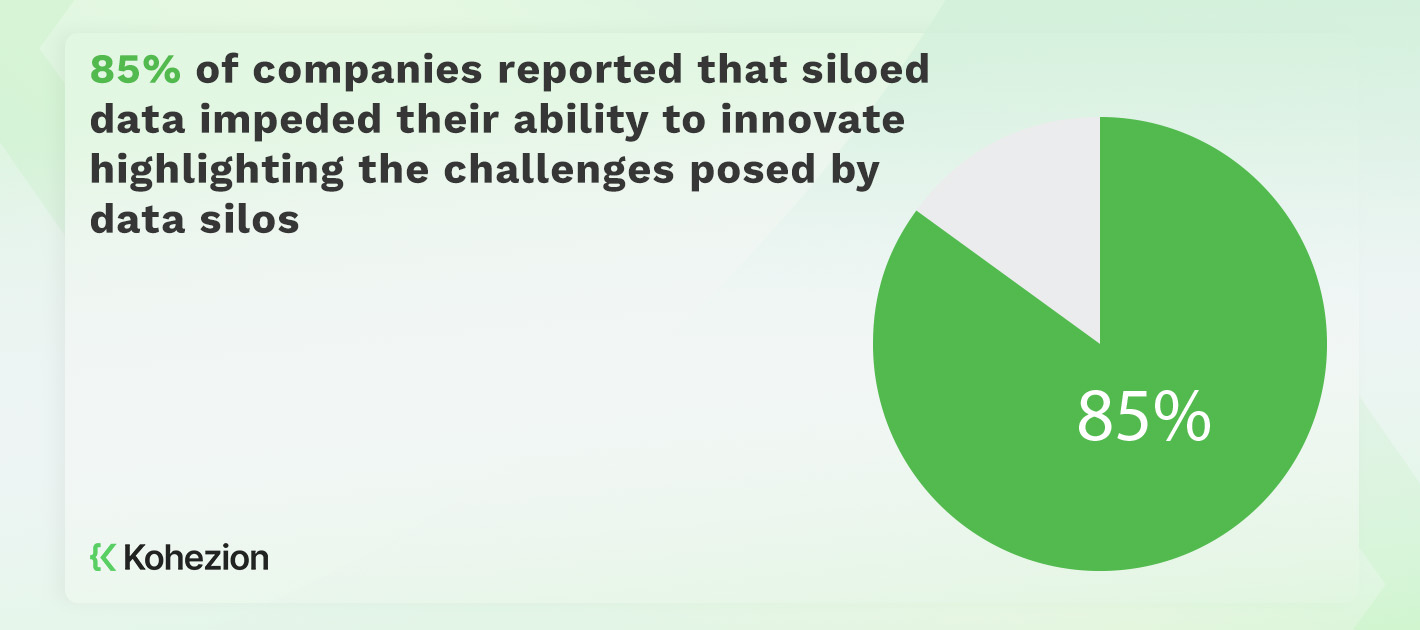
What departments are in danger of data silos?
1. Marketing
Data silos in the marketing department can negatively impact business performance by reducing productivity and customer satisfaction. When information is stored in different silos, it presents significant challenges for marketing operations, making it difficult to provide an excellent customer experience.
For instance, 47% of marketers consider data silos the main reason for not having an accurate view of the customer journey. This makes it impossible to provide a seamless customer experience, leading to customer frustration and ultimately impacting business performance. Data silos can occur when business departments function independently, with marketing, sales, and support teams developing
distinct procedures for processing data and leveraging insights.
2. Sales
When different teams use separate databases to access the same customer data, there is no single source of truth. This can result in changes made to one record in one database not being reflected in another database. As a result, sales agents may not be able to identify potential upsell opportunities or determine if a client account has an open issue.
3. Customer Service
Customer service departments can contribute to data silos when they store information in separate databases or systems, making it difficult for other teams to access and use the data. For example, if customer complaints and feedback are stored in one database while customer purchase history is stored in another, it can be challenging for marketing or sales teams to get a complete picture of the customer journey. This can lead to a scattered customer experience and reduced productivity, ultimately impacting customer satisfaction.
4. Finance
The finance department is at risk of developing data silos due to the large amount of data it creates and manages. This data can include information on expenses, profits, and financial reports. If this data is not properly integrated with other departments, it can lead to duplication of data and a lack of resource
quality.
5. Product Development
Data silos can have a negative impact on product development by creating inefficiencies and delays in the process. Departments that are most at risk of experiencing data silos are those that work independently and do not collaborate with other departments. For example, if the marketing department has data that is not shared with the product development department, it could lead to delays in the development process as the product development team may not have all the necessary information to create a product that meets customer needs.
6. Operations
In operations, departments that handle different stages of the production process, such as procurement, inventory management, and shipping, are most susceptible to data silos. Siloed data in these departments may include information on vendor performance, raw material availability, and shipping schedules. Without access to this information, departments may make decisions that are not aligned with the overall goals of the organization, leading to inefficiencies and missed opportunities for cost savings and process improvements.
7. IT
The IT department plays a crucial role in preventing data silos within an organization. They can help identify existing data silos and work to integrate data efficiently and accurately, using techniques such as scripting, ETL tools, or integration platforms as a service (iPaaS). Communication and collaboration between IT and other departments are essential in preventing data silos.
Data silos can be detrimental to the IT department, as they may have to spend a significant amount of time and resources cleaning up and integrating data. Therefore, it is vital for the IT department to work closely with other departments to ensure the smooth flow of data throughout the organization.
8. Corporate Governance
Corporate governance can contribute to data silos in certain departments due to the typical hierarchical structure of governance. In this structure, departments may operate independently, with little communication or collaboration with other departments. This can result in data silos, where data is stored and managed independently within each department.
To overcome these barriers and promote cross-departmental collaboration, organizations can implement enterprise metadata management and data governance programs. These programs establish common standards and policies for data management, ensuring that data is aligned with business goals.
Start building with a free account
Frequently Asked Questions
Data silos occur due to a lack of communication between departments, the desire of one department to control its own information, and the lack of an enterprise-wide standard for collecting and storing data.
Additionally, technology limitations, company growth, organizational structures, and decentralized IT services can also contribute to the problem.
Breaking down data silos in an organization requires a top-down initiative and a company-wide education program. One way to do this is through data integration, which involves replicating data from various sources into a centralized repository, such as a data warehouse, where it can be shared and analyzed across the company.
Data silo issues can be addressed by encouraging a collaborative workplace, developing new processes for storing data, and using data integration software to create centralized data. To encourage collaboration, executives should create an organization that embraces teamwork, and departments should be encouraged to work together. Data integration software can be used to replicate data from various sources into a single centralized repository, such as a data warehouse, where it can be analyzed and shared across the company.
One of the most effective solutions to data silos is to centralize data in a cloud-based data warehouse or data lake. This allows for easy access and analysis of data from disparate sources, while also ensuring a 360-view of company data. However, undoing silos can be difficult due to permissions and hierarchies. Encouraging a collaborative workplace and developing new processes for storing data can help with this.
Data integration software is also effective in replicating data from databases and other sources into a single centralized repository. While these solutions have pros and cons, they have been successfully implemented by many organizations. For example, a global insurance company centralized its data into a data lake, which led to faster and more accurate analysis, improved data quality, and increased collaboration across teams.
